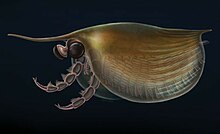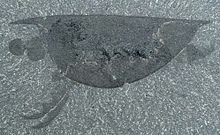Isoxys
| Isoxys Temporal range:
| |
|---|---|

| |
| Isoxys curvirostratus from the Chengjiang Biota | |

| |
| Fossil of Isoxys acutangulus from the Burgess Shale | |
| Scientific classification | |
| Domain: | Eukaryota |
| Kingdom: | Animalia |
| Phylum: | Arthropoda |
| Order: | †Isoxyida |
| Family: | †Isoxyidae |
| Genus: | †Isoxys Walcott, 1890 |
| Species | |
|
See text | |
Isoxys (meaning "equal surfaces") is a
Description
Species of Isoxys have roughly semicircular bivalved carapaces, which vary in morphology between species. The front and rear edges of the carapaces bear forward and posterior facing spines, respectively which in some species are greatly elongated.[3] The carapaces of Isoxys are typically 1.1 to 3.3 centimetres (0.43 to 1.30 in) in length, excluding the spines, though some species are known to reach over 6 centimetres (2.4 in). In long-spined species when including spine length, some specimens exceed 10 centimetres (3.9 in).[4] The opening angle of the carapace was close to vertical, giving it a narrow profile when viewed from above.[3]
The head had a pair of large spherical stalked eyes, as well as a pair of upward-curling frontal appendages, which have a varying number of podomeres/segments, depending on the species. Most podomeres on the frontal appendages have upward-facing
Ecology
Species of Isoxys are thought to have been actively swimming predators, using its frontal appendages to capture soft-bodied prey, with the frontalmost pairs of biramous limbs aiding in food processing.
Taxonomy

Isoxys is thought to be one of the
Species
20 species of Isoxys have been described,[3] which have a global distribution, having been found in North America, Siberia, Australia, China and Europe, spanning from Cambrian Series 2 into the Miaolingian.[11]
- Isoxys chilhoweanus Walcott, 1890 (type) Tennessee, USA, Cambrian Series 2
- Isoxys acutangulus (Walcott, 1908) Balang Formation, Guizhou, China, Cambrian Stage 4, Burgess Shale, Canada, Miaolingian
- Isoxys auritus (Jiang, 1982) Chengjiang Biota, Yunnan, China, Cambrian Stage 3, Balang Formation, China, Cambrian Stage 4
- Isoxys curvirostratus Vannier & Chen, 2000 Chengjiang Biota, China, Cambrian Stage 3
- Isoxys paradoxus Hou, 1987 Chengjiang Biota, China, Cambrian Stage 3
- Isoxys zhurensis Ivantsov, 1990 Sinsk Formation, Siberia, Cambrian Series 2
- Isoxys bispinatus Cui, 1991 Shuijintuo Formation, Sichuan, China, Cambrian Series 2
- Isoxys glaessneri García−Bellido, Paterson, Edgecombe, Jago, Gehling & Lee, 2009 Emu Bay Shale, Australia, Cambrian Stage 4
- Isoxys communis Glaessner, 1979 Emu Bay Shale, Australia, Cambrian Stage 4
- Isoxys guanduensis Wang et al., 2012 Guanshan Biota, Yunnan, China, Cambrian Stage 4
- Isoxys minor Luo et al., 2008 Guanshan Biota, Yunnan, China, Cambrian Stage 4
- Isoxys wudingensis Luo & Hu, 2006 Guanshan Biota, Yunnan, China, Cambrian Stage 4
- Isoxys globulus Liu et al., 2018 Balang Formation, Guizhou, China, Cambrian Stage 4
- Isoxys jianheensis Liu et al., 2018 Balang Formation, Guizhou, China, Cambrian Stage 4
- Isoxys volucris Williams, Siveter & Peel, 1996, Sirius Passet, Greenland, Cambrian Stage 3
- Isoxys mackenziensis Kimmig & Pratt 2015 Rockslide Formation, Canada, Miaolingian
- Isoxys longissimus Simonetta & Delle Cave, 1975 Burgess Shale, Canada, Miaolingian
- Isoxys carbonelli Richter & Richter, 1927, Pedroche Formation, Spain, Cambrian Series 2
- Isoxys shandongensis Wang and Huang, 2010, Mantou Formation, Shandong, China, Miaolingian
Indeterminate species are also known from the Spence Shale of Utah, dating to the Miaolingian, as well as the Kaili Biota in Guizhou, China, which also dates to the Miaolingian.[11]
See also
- Arthropod
- Cambrian explosion
- Chengjiang biota
- Paleobiota of the Burgess Shale
References
External links
- "Isoxys acutangulus". Burgess Shale Fossil Gallery. Virtual Museum of Canada. 2011. Archived from the original on 2020-11-12. Retrieved 2023-01-21.
